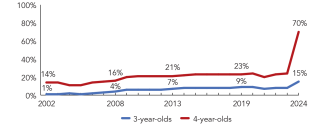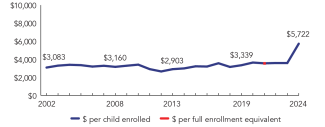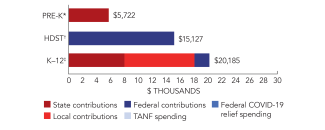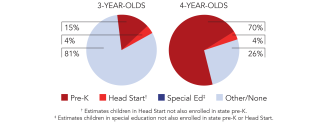
State of Preschool
Colorado
Access Rankings
Resource Rankings
Total Benchmarks Met
Overview

During the 2023-2024 school year, Colorado preschool enrolled 52,617 children, an increase of 31,277 from the prior year. State spending totaled $301,057,683, up $224,638,777 (294%), adjusted for inflation, since last year. State spending per child equaled $5,722 in 2023-2024, up $2,141 from 2022-2023, adjusted for inflation. Colorado met 2 of 10 quality standards benchmarks but will meet additional benchmarks once their new program’s standards are fully in place.
What's New

The passage of Proposition EE in November 2020 and related laws (e.g., HB22-1295) in 2022 established the Colorado Department of Early Childhood (CDEC) and the Colorado Universal Preschool program. The new statewide universal preschool program launched July 1, 2023, at which time the Colorado Preschool Program sunsetted. The new program, which is covered in this report for the first time this year, is administered by the CDEC using a mixed delivery model, and in collaboration with Local Coordinating Organizations rather than local school districts. It is funded primarily by a nicotine and tobacco tax. The Colorado Department of Education will continue to administer federal and state funding for special education in accordance with IDEA and Exceptional Children’s Educational Act (ECEA) for children ages three through five.
Background
The Colorado Preschool Program (CPP) launched in 1988 for 4-year-olds who needed language development support. , in hopes of lowering school dropout rates and reducing dependence on public assistance. It became a permanent program in 1992 and expanded eligibility to young children lacking overall school readiness due to family risk factors, as defined by statute. The 2022-2023 school year was the last year of CPP.
The Colorado Universal Preschool program began operating in the 2023-2024 school year and is administered by the new CDEC. The new program uses a mixed delivery model where funding goes directly to providers based on enrollment and services provided. Families can choose a licensed community-based program, a school-based program, or a licensed home-based provider. All four-year-olds in the state are eligible to attend the program and receive up to 15 hours of preschool each week. Depending on available funding, families may qualify for 30 hours (full-day) for their 4-year-old if they are low- income and meets at least one qualifying factor that may impact their future academic achievement. Three-year-olds with a qualifying
factor (including an IEP, low-income status, non-English home language, in foster care, experiencing homelessness) can also attend the program for a minimum of 10 hours per week. The program is offered for a 10-month school year.
As of the first year of the Colorado Universal Preschool Program, CDEC is still developing several policies for the program which will be implemented over the next few years. The Colorado Department of Universal Preschool resource bank was launched in January 2025 which includes resources related to instructional practices (e.g., curricula), family and community engagement, and healthy development.
Colorado Universal Program
Access
Resources
| Total state pre-K spending | $301,057,683 |
| Local match required? | No |
| State Head Start spending | $0 |
| State spending per child enrolled | $5,722 |
| All reported spending per child enrolled* | $5,722 |

*Pre-K programs may receive additional funds from federal or local sources that are not included in this figure. †Head Start per-child spending includes funding only for 3- and 4-year-olds. ‡K–12 expenditures include capital spending as well as current operating expenditures.
Colorado Quality Standards Checklist
| Policy | Requirement | Benchmark | Meets Benchmark? |
|---|---|---|---|
For more information about the benchmarks, see the Executive Summary and the Roadmap to State pages. | 2benchmarks met | ||
| Early Learning & Development Standards Benchmark | Comprehensive, aligned, supported, culturally sensitive | Comprehensive, aligned, supported, culturally sensitive | |
| Curriculum Supports Benchmark | Approval process & supports | Approval process & supports | |
| Teacher Degree Benchmark | Other | BA | |
| Teacher Specialized Training Benchmark | Other | Specializing in pre-K | |
| Assistant Teacher Degree Benchmark | Other | CDA or equivalent | |
| Staff Professional Development Benchmark | 15 hours/year | For teachers & assistants: At least 15 hours/year; individual PD plans; coaching | |
| Maximum Class Size Benchmark | 20 (3-year-olds); 24 (4-year-olds) | 20 or lower | |
| Staff to Child Ratio Benchmark | 1:10 (3-year-olds); 1:12 (4-year-olds) | 1:10 or better | |
| Screening & Referral Benchmark | Immunizations & Full physical exam; Referrals determined locally | Vision, hearing & health screenings; & referral | |
| Continuous Quality Improvement System Benchmark | Structured classroom observations per QRIS; Data used for program improvement | Structured classroom observations; data used for program improvement | |
